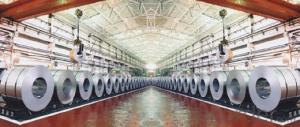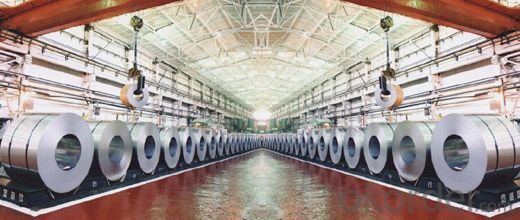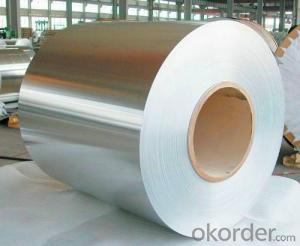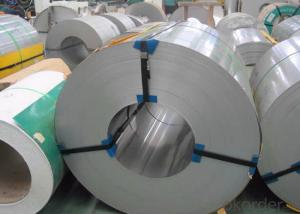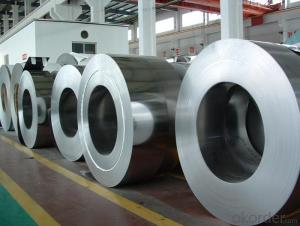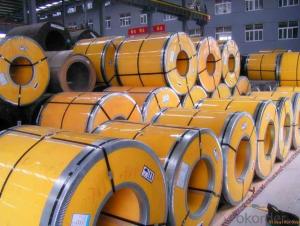Stainless Steel Coil Cold Rolled 304
- Loading Port:
- China Main Port
- Payment Terms:
- TT OR LC
- Min Order Qty:
- -
- Supply Capability:
- 5000 m.t./month
OKorder Service Pledge
OKorder Financial Service
You Might Also Like
Standard: | AISI,ASTM,BS,DIN,GB,JIS | Grade: | 304 | Thickness: | 0.3-3.0mm |
Place of Origin: | China Mainland | Brand Name: | CNBM | Model Number: | 304 |
Type: | Steel Coil | Technique: | Cold Rolled | Surface Treatment: | 2B, BA |
Application: | Medical instruments, building, chemical food industry agriculture | Width: | 500-2000mm | Length: | Coil |
finish: | 2B, BA | item: | 304 cold rolled stainless steel coil | density: | 7.93 |
Chemical composition: |
| ||||||
C | Si | Mn | Cr | Ni | S | P | |
≤0.07 | ≤1.0 | ≤2.0 | 18.0~20.0 | 8.0~11.0 | ≤0.03 | ≤0.035 | |
mechanical properties: |
| ||||||
Tensile strength σb (MPa) | Conditions yield strength 0.2 sigma (MPa) | Elongation δ5 (%) | Section shrinkageψ (%) | Hardness | |||
520 | 205 | 40 | 60 | ≤1 | |||
Cold Rolled Stainless Steel Coil 304
Packaging Detail:standard export packing or as customer's requirements
Delivery Detail:7-15 days after the order
MOQ: 25mt
- Q: What are the common length tolerances for stainless steel strips?
- The specific industry and application requirements determine the common length tolerances for stainless steel strips, which can vary. Generally, the range for these tolerances is from +/- 0.005 inches to +/- 0.030 inches. These tolerances guarantee that the stainless steel strips are accurately cut and measured to the specified dimensions, resulting in an ideal fit and optimal performance in different applications. To determine the precise length tolerances needed for stainless steel strips in a particular application, it is crucial to refer to the specific industry standards and customer specifications.
- Q: Can 111 stainless steel strips be formed into complex shapes?
- Complex shapes can indeed be formed using 111 stainless steel strips. Stainless steel is renowned for its exceptional formability and versatility. It possesses the remarkable ability to be easily manipulated, bent, and shaped into a wide range of intricate geometries. The quantity of strips, specifically 111 in this instance, does not impose any limitations on the creation of complex shapes. Depending on the desired final form, the process of transforming stainless steel strips into intricate shapes may involve a variety of techniques, including bending, rolling, stamping, or welding. By employing the appropriate tools, expertise, and methodologies, stainless steel strips can be effectively fashioned into elaborate and multifaceted shapes, catering to diverse applications across industries such as architecture, automotive, aerospace, and beyond.
- Q: What are the common uses of stainless steel strips in the mining industry?
- Stainless steel strips are commonly used in the mining industry for various applications such as conveyor systems, screening equipment, and storage tanks due to their durability, corrosion resistance, and high strength properties. Additionally, they are used in the construction of mining machinery, support structures, and extraction tools, as well as for lining pipes and vessels to withstand extreme conditions and prevent material degradation.
- Q: What are the common thickness tolerances for stainless steel strips?
- The common thickness tolerances for stainless steel strips can vary depending on the specific requirements and industry standards. However, typical tolerance ranges for stainless steel strips are generally around +/- 0.005 to 0.010 inches or +/- 0.127 to 0.254 millimeters.
- Q: What are the factors affecting the creep resistance of 111 stainless steel strips?
- The factors affecting the creep resistance of 111 stainless steel strips include the alloy composition, grain size, temperature, and applied stress. The presence of elements like chromium, nickel, and molybdenum enhances creep resistance. A fine grain structure enhances resistance, while higher temperatures and applied stresses can reduce the creep resistance of the stainless steel strips.
- Q: Can stainless steel strips be used in HVAC systems?
- Indeed, in HVAC systems, stainless steel strips find utility. Stainless steel, a material known for its exceptional durability and resistance to corrosion, proves its suitability for an array of applications within heating, ventilation, and air conditioning systems. Commonly employed in the fabrication of ductwork, air handling units, heat exchangers, and various other components, stainless steel strips guarantee enduring performance by withstanding corrosion, heat, and extreme temperatures, thus mitigating the necessity for frequent maintenance or replacement. Furthermore, their ability to withstand high-pressure environments ensures the integrity and efficiency of the HVAC system.
- Q: Can stainless steel strips be customized?
- Yes, stainless steel strips can be customized. Stainless steel is a versatile material that can be easily cut, shaped, and formed according to specific requirements. Customization options include cutting the strips into specific dimensions, shaping them into curves or angles, and adding additional features such as holes, notches, or slots. Stainless steel strips can also be customized in terms of surface finishes, including brushed, polished, or embossed finishes. Additionally, various grades of stainless steel are available, each with different properties and characteristics, allowing for further customization to meet specific needs such as corrosion resistance, strength, or heat resistance. Overall, stainless steel strips offer a wide range of customization possibilities to suit different applications and industries.
- Q: What are the dimensions of stainless steel strips?
- The dimensions of stainless steel strips can vary depending on the specific needs and requirements of the application. However, stainless steel strips are commonly available in various thicknesses ranging from 0.1mm to 6mm and widths ranging from 10mm to 2000mm. The length of stainless steel strips can also vary, but it is typically available in coils or rolls of standard lengths, such as 1000mm or 2000mm. Additionally, stainless steel strips can be custom-cut to specific dimensions to suit individual project requirements.
- Q: Are stainless steel strips resistant to phosphoric acid?
- Stainless steel strips, in general, exhibit resistance to phosphoric acid. The corrosion-resistant nature of stainless steel stems from the inclusion of chromium and other alloying elements. Phosphoric acid, being a comparatively mild acid, typically does not induce substantial corrosion or harm to stainless steel. Nevertheless, it is crucial to acknowledge that extended exposure to concentrated or high-temperature phosphoric acid may still lead to surface corrosion or pitting on stainless steel. Consequently, it is advisable to minimize contact with phosphoric acid to preserve the longevity and aesthetics of stainless steel strips.
- Q: Can 111 stainless steel strips be used in high-temperature applications?
- No, 111 stainless steel strips cannot be used in high-temperature applications as they lack the necessary heat resistance required for such conditions.
Send your message to us
Stainless Steel Coil Cold Rolled 304
- Loading Port:
- China Main Port
- Payment Terms:
- TT OR LC
- Min Order Qty:
- -
- Supply Capability:
- 5000 m.t./month
OKorder Service Pledge
OKorder Financial Service
Similar products
Hot products
Hot Searches
Related keywords
